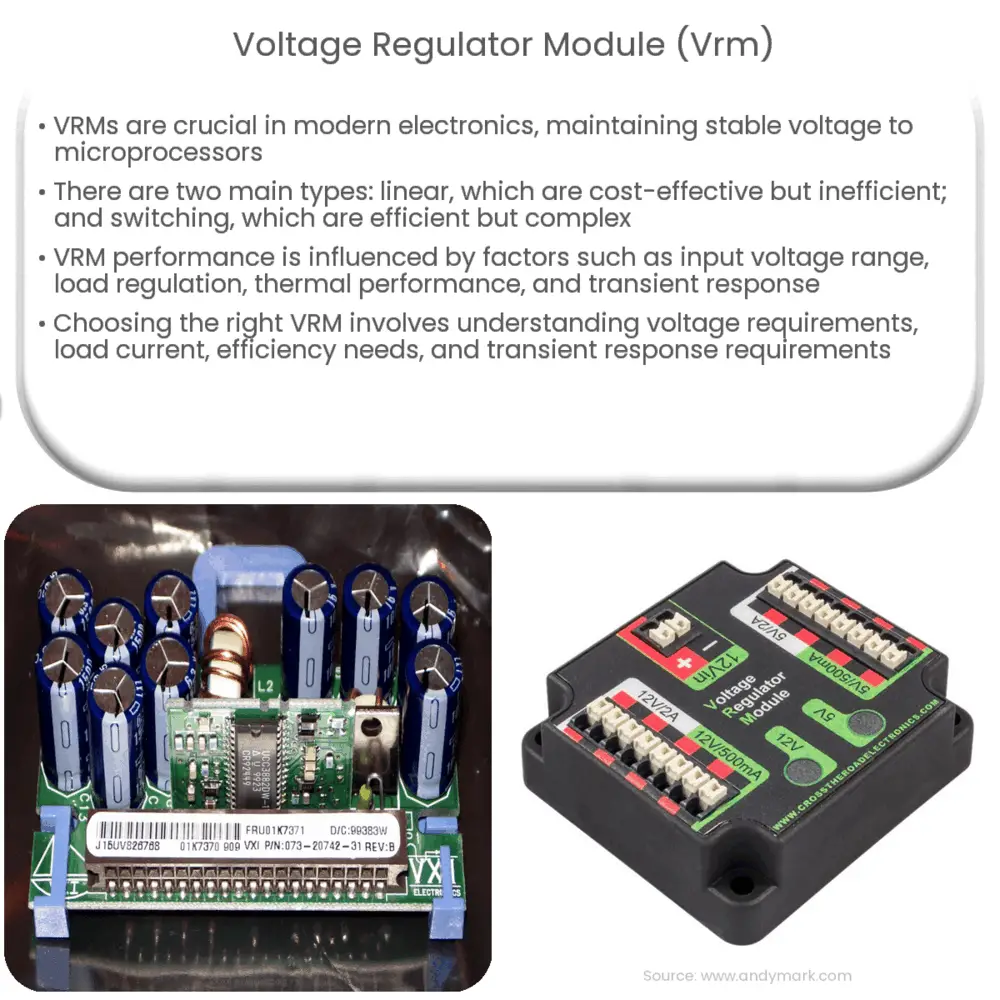A Voltage Regulator Module (VRM) is a compact circuit that maintains a stable voltage supply for microprocessors and other digital components.

Voltage Regulator Module (VRM): A Comprehensive Guide
Voltage Regulator Modules (VRMs) play a critical role in the operation of modern electronic devices. These small but essential components are responsible for maintaining a stable voltage supply to a microprocessor or other digital components in the system. In this two-part article, we will explore the fundamentals of VRMs, their importance, and how they work.
Understanding the Importance of Voltage Regulation
As electronic devices become more advanced, the demand for stable and accurate voltage levels increases. A steady voltage supply is necessary for the smooth operation of integrated circuits (ICs) and microprocessors, as fluctuations can lead to malfunctions, poor performance, or even permanent damage. Voltage regulators ensure that these components receive the correct voltage by converting the input voltage to the required level.
What is a Voltage Regulator Module (VRM)?
A Voltage Regulator Module (VRM) is a specialized circuit that takes an input voltage and converts it to a stable, lower output voltage for use by the device’s components. The output voltage is typically specified by the manufacturer, and the VRM’s primary function is to ensure that the supply remains constant, even if the input voltage or load conditions change.
VRMs are commonly found on motherboards and are used to regulate the power supply for the Central Processing Unit (CPU) and Graphics Processing Unit (GPU). They can also be found in other electronic devices that require precise voltage control, such as servers, laptops, and networking equipment.
Types of Voltage Regulator Modules
There are two main types of VRMs: linear regulators and switching regulators. Each type has its advantages and disadvantages, depending on the specific application.
Linear Regulators
Linear regulators use a voltage-controlled resistor to maintain a constant output voltage. They are simple, cost-effective, and provide a low-noise output. However, they can be inefficient, especially when there is a significant difference between the input and output voltages. This inefficiency results in heat generation, which can be problematic in high-power or thermally sensitive applications.
Switching Regulators
Switching regulators use a combination of inductors, capacitors, and switches to convert the input voltage to the desired output level. They are more efficient than linear regulators, as they minimize heat generation and can handle a wider range of input voltages. However, they are more complex, larger in size, and can generate more electrical noise than linear regulators.
VRM Components and Design
A typical VRM consists of several key components, including voltage regulator ICs, inductors, capacitors, and MOSFETs (Metal-Oxide-Semiconductor Field-Effect Transistors). The design of a VRM is crucial in determining its performance, efficiency, and reliability.
In the next part of this article, we will delve deeper into the intricacies of VRM design, the factors affecting performance, and how to select the right VRM for your application.
Factors Affecting VRM Performance
Several factors can impact the performance and efficiency of a VRM. Some of the key considerations include:
- Input voltage range: VRMs must be able to handle a range of input voltages while maintaining a stable output. A wider input voltage range provides greater flexibility in various applications.
- Load regulation: Load regulation refers to the ability of a VRM to maintain a constant output voltage as the load current changes. A good load regulation ensures that the VRM provides consistent power to the components, even during fluctuations in the current demand.
- Thermal performance: VRMs generate heat during operation, and their efficiency is affected by temperature. Efficient thermal management is crucial to prevent overheating and ensure reliable performance.
- Transient response: Transient response is the ability of a VRM to quickly adjust its output voltage in response to sudden changes in load conditions. A fast transient response helps maintain voltage stability and minimize voltage overshoot or undershoot.
Selecting the Right VRM for Your Application
Choosing the appropriate VRM for your application depends on several factors, such as the required output voltage, current, efficiency, and thermal management. Here are some guidelines to help you select the right VRM:
- Understand your voltage requirements: Determine the input voltage range and the required output voltage for your application. This information will help you identify the appropriate type of VRM (linear or switching) and suitable components.
- Calculate the load current: Calculate the maximum load current that the VRM needs to handle. This value will help you choose components with appropriate current ratings to ensure reliable performance.
- Consider efficiency and thermal management: Evaluate the efficiency requirements and thermal constraints of your application. If heat dissipation is a concern, you may need to opt for a more efficient VRM design or incorporate additional cooling solutions.
- Assess transient response requirements: Consider the transient response needs of your application. If fast voltage adjustments are necessary, choose a VRM with a quick transient response to minimize voltage instability.
- Consult datasheets and manufacturer recommendations: Review datasheets and manufacturer recommendations for VRM components to ensure compatibility and optimal performance in your specific application.
Conclusion
Voltage Regulator Modules (VRMs) are essential components in modern electronic devices, ensuring a stable and accurate voltage supply to microprocessors and integrated circuits. By understanding the principles of VRM operation, the differences between linear and switching regulators, and the factors affecting performance, you can select the right VRM for your application and ensure the smooth operation of your electronic devices.

